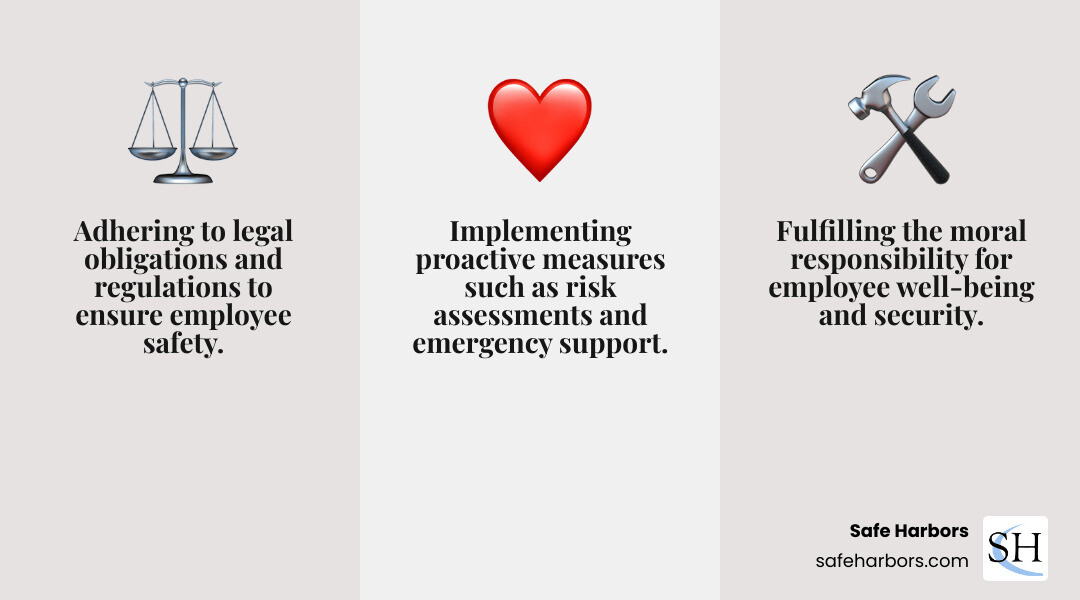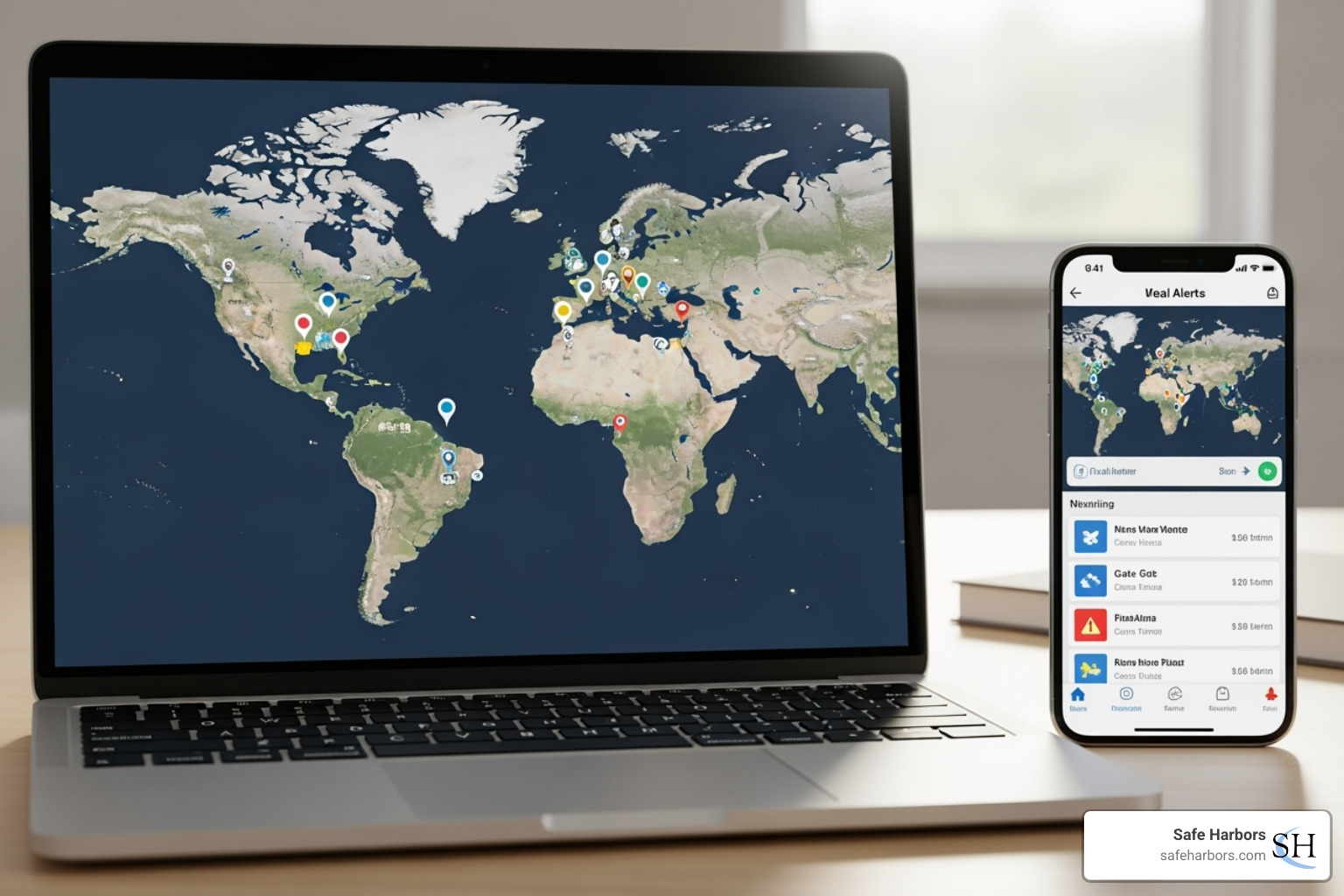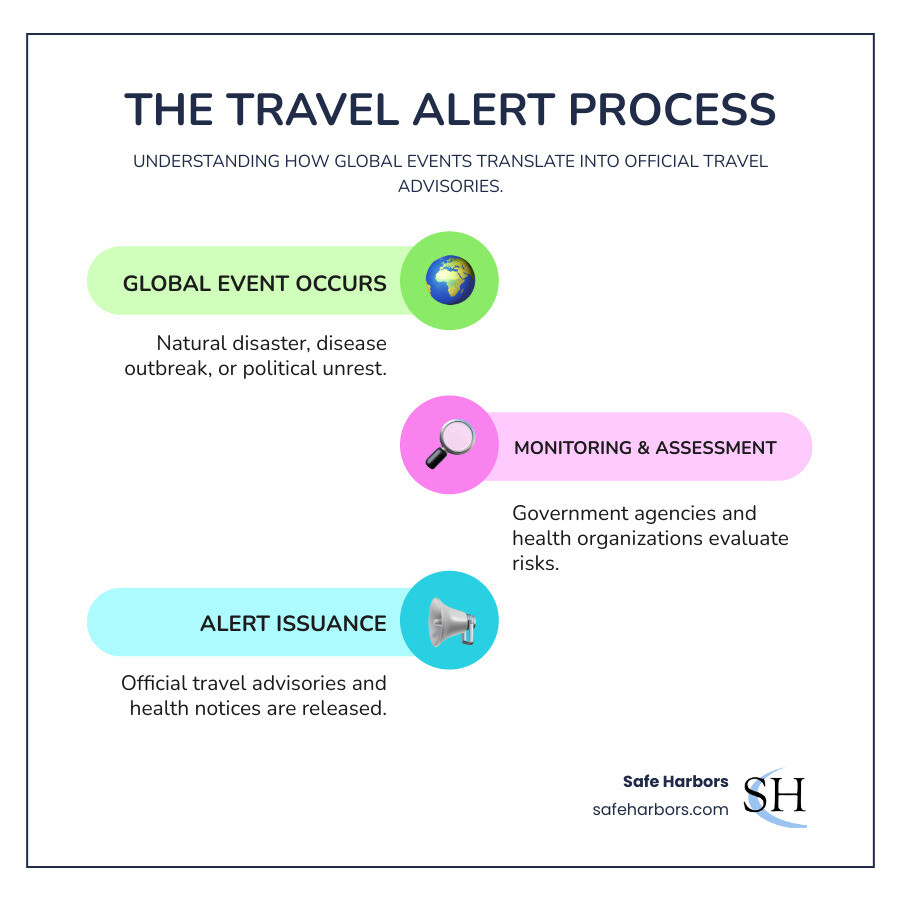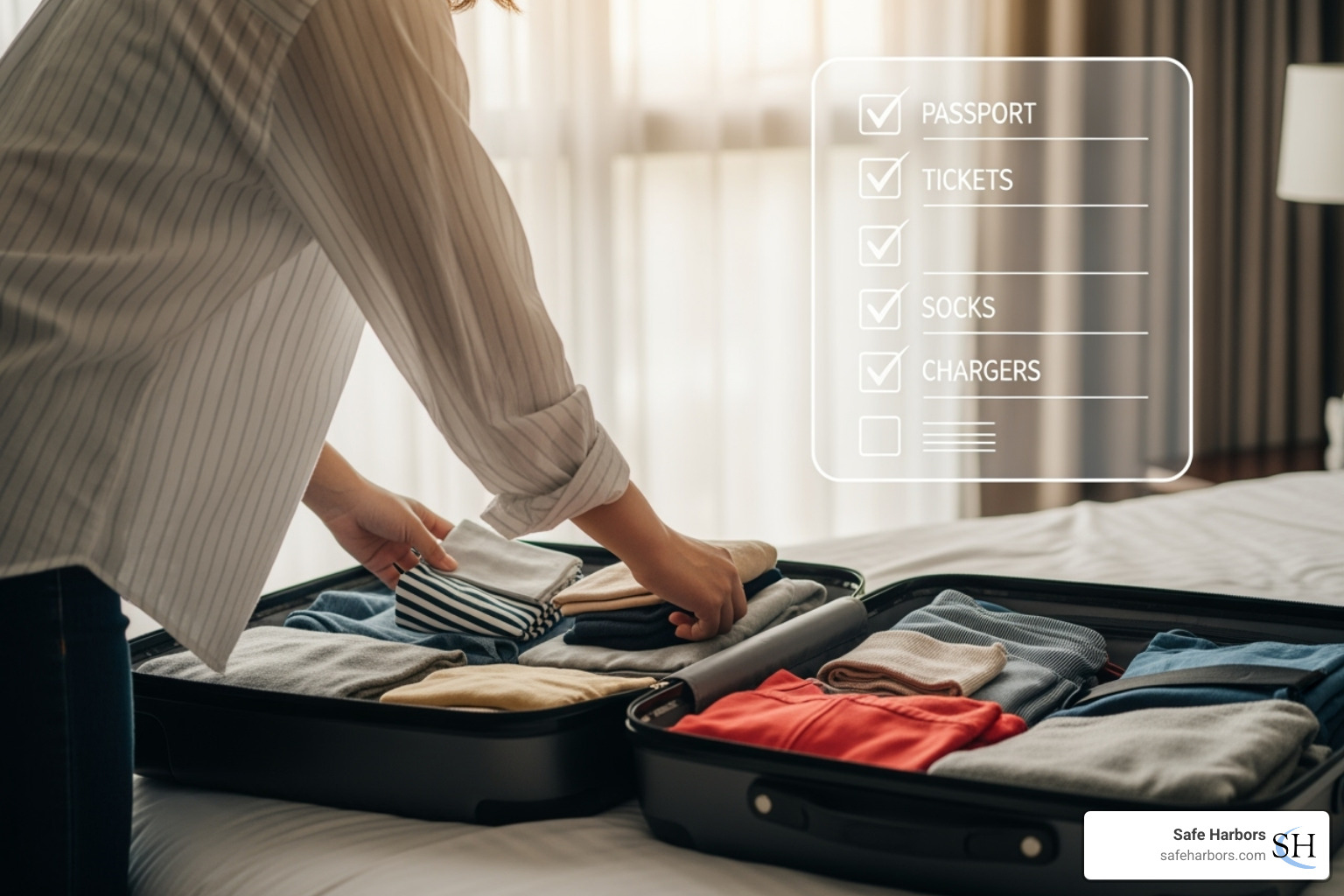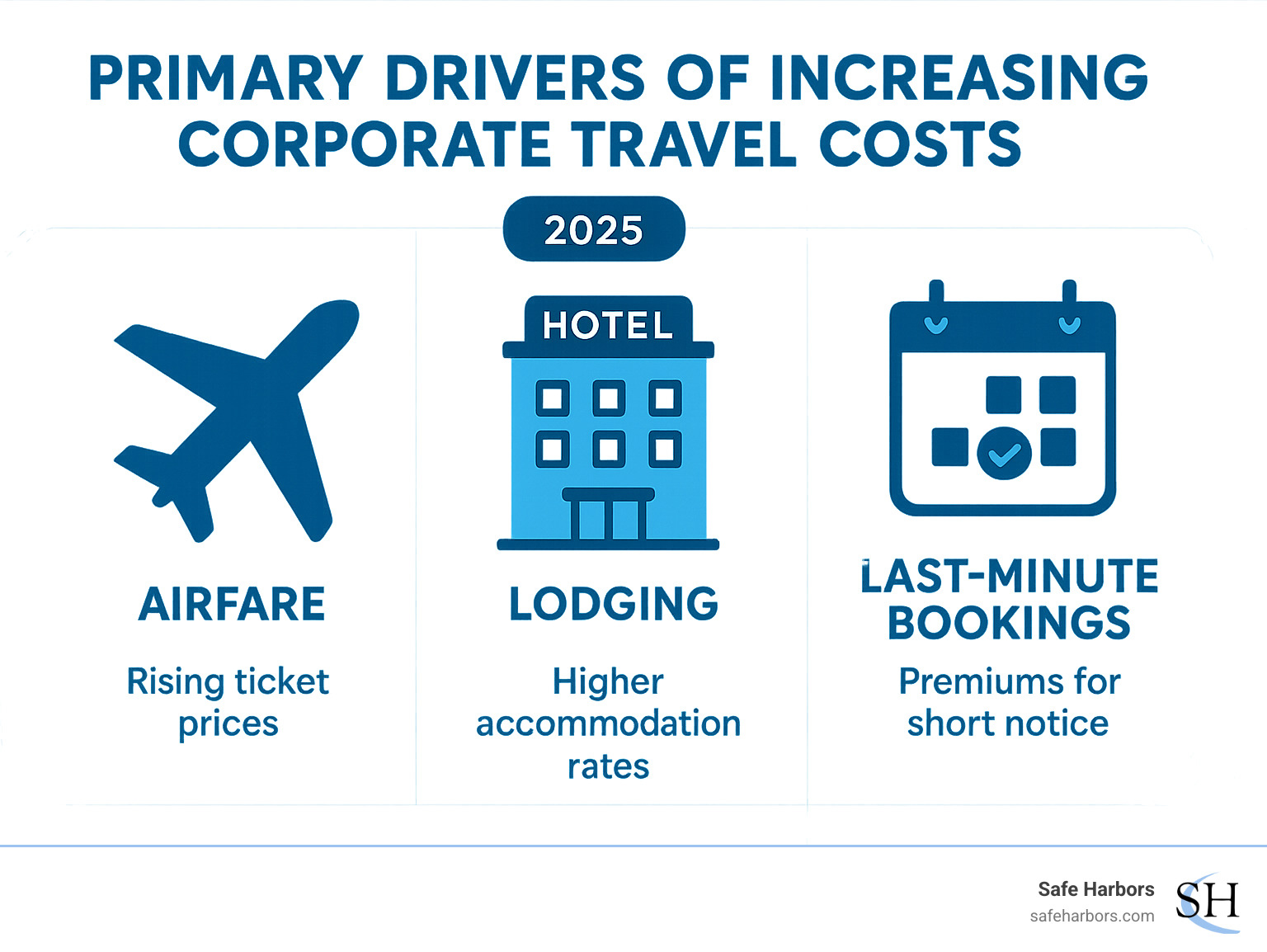Why Emergency Travel Service Can Save Your Trip—and Your Life

Emergency travel service provides immediate assistance when travelers face medical crises, security threats, or logistical disasters abroad. Here's what you need to know:
Key Emergency Travel Services:
- Medical assistance: 24/7 medical referrals, evacuation, and hospital payment guarantees
- Security support: Evacuation from dangerous areas, real-time threat alerts
- Logistical help: Lost passport assistance, emergency cash, translation services
- Global coverage: Worldwide network with local expertise in 150+ countries
Imagine managing travel for a global team when an employee is hospitalized in a foreign country. The local hospital demands $50,000 upfront, your employee can't communicate with doctors, and you're unsure how to arrange a medical evacuation.
This scenario is common: 1 in 3 travelers experience health issues abroad, and medical evacuation can cost up to $300,000. For corporate travel managers, these emergencies create significant financial and duty of care liability.
Traditional travel insurance often only reimburses you later, leaving you to manage the crisis alone. When seconds count, you need a service that acts immediately.
Modern emergency travel services bridge this gap by providing real-time crisis response. They maintain networks of vetted medical professionals, security experts, and local coordinators who can mobilize within hours. The best services offer integrated platforms that connect directly with your travel management system, ensuring seamless support when disasters strike.
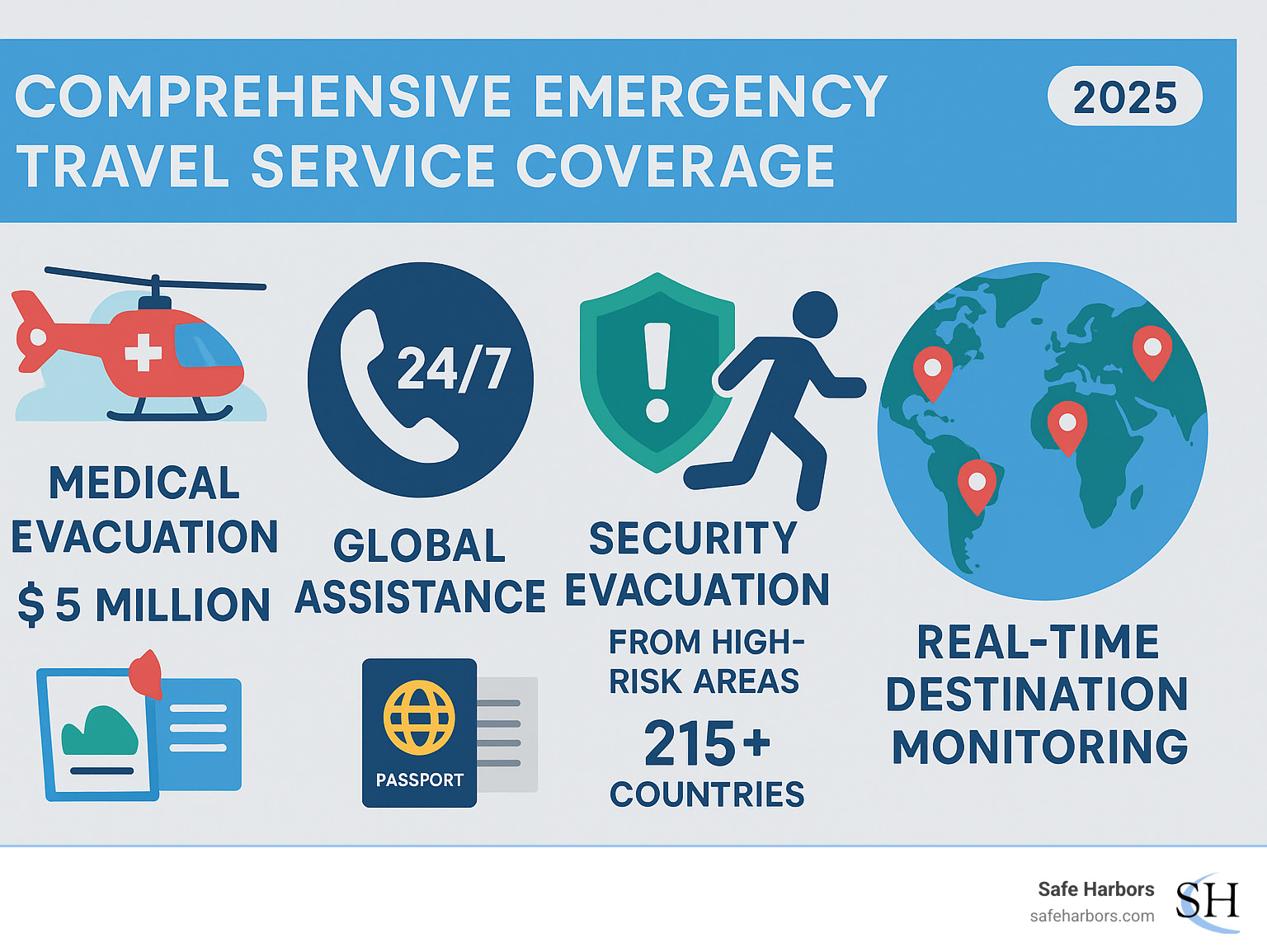
Understanding Emergency Travel Assistance: What It Is and Why It Matters
Travel is an incredible experience, but even the most carefully planned trips can take an unexpected turn. That's where emergency travel service steps in, acting as your crucial safety net. It's not just a phone number to call; it's a dedicated team ready to spring into action, wherever you are in the world.
What is Emergency Travel Assistance?
At its core, emergency travel assistance is a specialized service designed to provide immediate, hands-on help to travelers facing unexpected crises abroad. Think of it as a 24/7 global support system for everything from a medical emergency to a lost passport.
Typically, an emergency travel service offers:
- 24/7 Support: Access to multilingual coordinators around the clock.
- Global Network: A vast network of vetted medical professionals, air ambulance providers, and local agents.
- Medical Support: Coordination of medical care, hospital admissions, evacuations, and repatriation.
- Logistical & Security Support: Assistance with travel disruptions, lost documents, and evacuation from high-risk situations.
These services go beyond what typical travel insurance provides by actively managing the crisis, rather than simply reimbursing costs after the fact. This distinction is critical when you're in a foreign country dealing with language barriers and unfamiliar systems.
Why is it Crucial for Travelers?
The importance of an emergency travel service cannot be overstated. Consider these reasons:
- Safety Net Against the Unexpected: With 1 in 3 travelers facing health issues abroad, emergencies are a real risk. International medical evacuation can cost hundreds of thousands of dollars. An assistance service protects you from these bankrupting expenses, with coverage often reaching up to $100,000 for evacuation and $5 million for medical treatment.
- Access to Experts: In a crisis, you need professional guidance. An emergency travel service connects you with experts who understand international protocols, local laws, and medical standards.
- Overcoming Barriers: Language differences and cultural nuances can turn a difficult situation into an impossible one. Assistance providers offer translation services and leverage their local networks to bridge these gaps.
- Navigating Foreign Systems: An emergency travel service can arrange hospital admissions, guarantee payments, and monitor your medical care, providing peace of mind in unfamiliar healthcare systems.
- Corporate Duty of Care: For businesses, providing this service is a vital part of their Business Travel Duty of Care and Risk Management responsibilities. The Compelling Security Benefits of Corporate Travel Management include knowing your travelers are protected around the clock, anywhere in the world.
The Spectrum of an Emergency Travel Service
When you're far from home, it's reassuring to know you're not alone. An emergency travel service is a comprehensive suite of solutions designed to tackle nearly any crisis. Think of it as your personal global support team, ready to step in no matter the hurdle.
From medical issues to security concerns, these services offer a lifeline. This all-encompassing approach is why having a solid Travel Risk Management plan is so vital for both individual travelers and businesses.
Medical and Health-Related Support
Getting sick or injured while traveling is a top concern. Our emergency travel service is built to ensure you get the best possible care, quickly and efficiently.
Our service provides immediate Medical Referrals to qualified local professionals. We can also offer Hospital Payment Guarantees to avoid treatment delays and provide Medical Monitoring to oversee your care. Many services now also offer convenient Virtual Consultations, allowing you to speak with a medical professional 24/7. If local care isn't sufficient, we arrange Medical Evacuation to transport you to an appropriate medical facility or back home. In the most difficult circumstances, our service handles the sensitive process of Repatriation of Remains.
For comprehensive coverage that includes modern benefits like virtual medical assistance, don't hesitate to Get a Quote for travel insurance.
Logistical and Personal Emergency Travel Service
Sometimes, smaller hiccups can derail your trip. Our emergency travel service is designed to smooth out these bumps.
We offer expert Lost Passport Guidance to help you get emergency travel documents. If you've lost access to funds, we can assist with Emergency Cash Transfers. Facing a language barrier? Our Translation Services are invaluable for communicating with local authorities or medical staff. We can also provide Emergency Messaging to relay urgent updates on your behalf and offer Lost Luggage Assistance to help track down your belongings. For an extra layer of support, our Concierge Travel Service goes beyond emergencies to make your entire journey seamless.
Security and Evacuation Services
Being prepared for security threats or natural disasters is more important than ever. A robust emergency travel service includes vital security components for peace of mind.
If political instability or civil unrest flares up, we can facilitate Political Unrest Evacuation. In the face of a natural disaster, our team can assist with Natural Disaster Support, including shelter and communication. For smart preparation, you might find our Six Tips for Prepping for a Natural Disaster While Away on Business helpful. Our service also provides crucial Security Advisories and Real-Time Alerts, ensuring you're always aware of evolving situations that might impact your safety.
These comprehensive services mean that no matter what unfolds, you have a knowledgeable team supporting you every step of the way.
Before You Go: A Traveler's Emergency Preparation Checklist
Even the best adventures can hit a bumpy patch. Being prepared for the unexpected isn't just smart, it's empowering. A little foresight can save a lot of stress if an emergency pops up. This preparation is crucial for businesses, which is why we often highlight Why Implementing a Travel Risk Plan for Employees is Crucial.
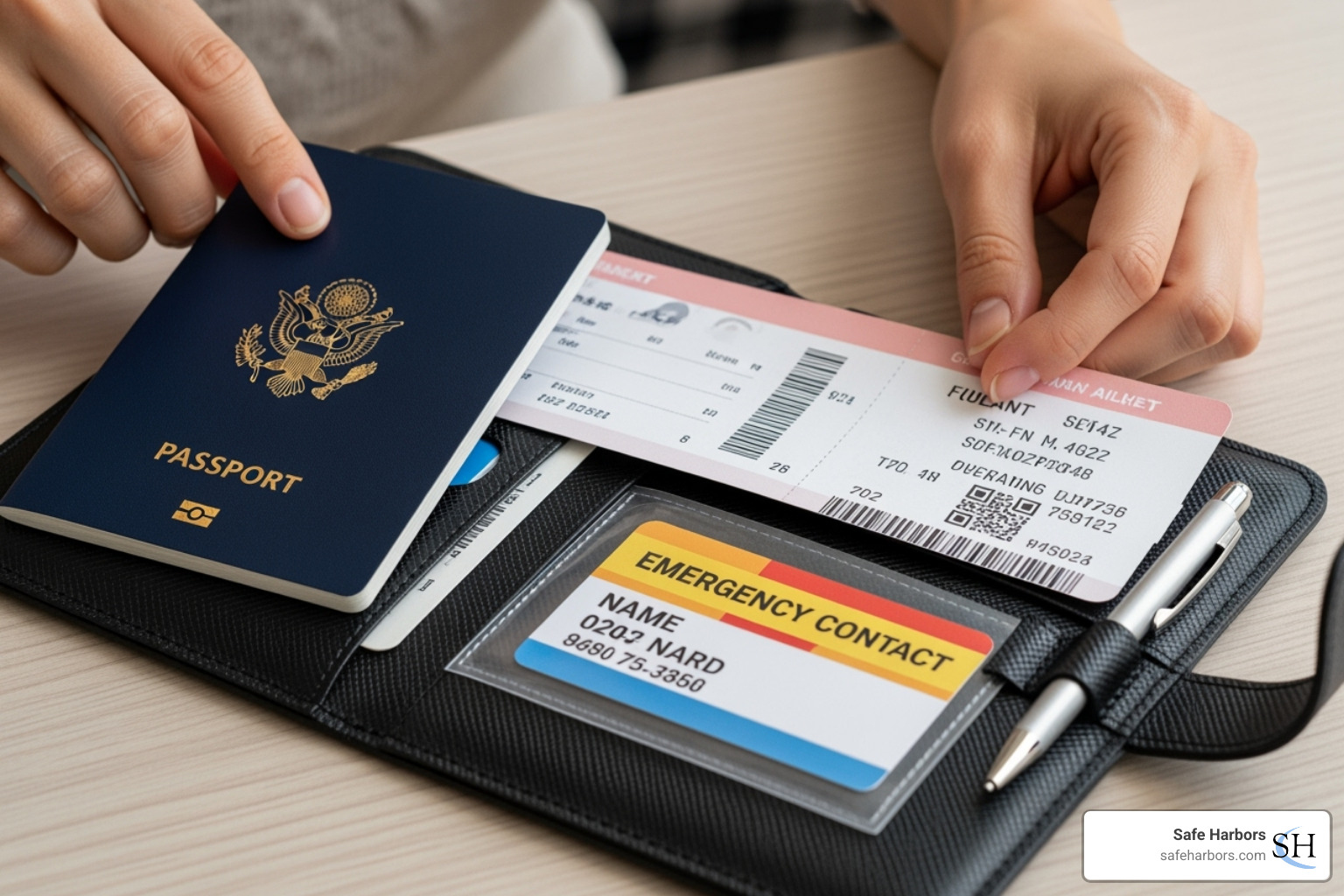
What Information to Have Ready
Having your essential information ready and easy to access is incredibly important. We suggest creating both a physical and digital "emergency kit" before you pack.
Here’s what you should have on hand:
- Passport & Visa Copies: Keep digital and physical copies separate from the originals.
- Itinerary Details: Flight numbers, hotel reservations, and key contacts.
- Emergency Contacts: A list of names and numbers for family, friends, and your employer.
- Insurance Policy Numbers: Your policy number and the emergency assistance contact number.
- Medical Information: A list of any pre-existing conditions, current medications (names and dosages), known allergies, and your blood type. Carry a doctor's note for any prescription medications.
- Financial Contacts: Your bank's international emergency number and credit card fraud hotlines.
- Local Embassy/Consulate Information: The address and emergency contact details for your country's embassy or consulate. For example, the Government of Canada offers information on how to request emergency assistance for its citizens abroad.
Once organized, share this information with a trusted person back home.
Choosing the Right Protection Plan
Picking the right emergency travel service or protection plan is a crucial step. The benefits of travel insurance for emergency medical situations are significant, helping cover costs that could otherwise be overwhelming.
It’s good to know the difference between Travel Insurance vs. Assistance Plans. Travel insurance typically reimburses financial losses (like a canceled trip or medical bills). An emergency travel service, however, provides immediate, active help and coordination during a crisis. Many comprehensive plans offer both.
Always Review Coverage Limits. Check the maximum coverage for medical expenses and evacuation. Emergency medical treatment coverage can go up to $5 million, and medical evacuation coverage can reach $100,000. Ensure these limits are adequate for your destination.
When looking at Specific Plan Features, look for a plan that offers 24/7 Global Assistance—this is non-negotiable. Confirm that Medical Evacuation & Repatriation is covered. Understand how your plan handles Pre-existing Conditions and verify if it includes COVID-19 Coverage. Finally, be aware of any Deductibles you may have to pay.
If you're traveling for work, understand your company's travel risk management plan. A smart corporate travel management company like Safe Harbors will have a strong emergency travel service built into their offerings.
In the Moment: How to Get Help During a Crisis
When you're far from home and an emergency strikes, it can feel overwhelming. Knowing the right steps to take can make all the difference, helping you stay calm and activate your support system.
Your first move should be to assess the situation and then reach out for help. This means contacting your provider (your emergency travel service or insurance company), contacting local authorities if needed, and contacting your embassy for consular support.

Handling a Medical Emergency
A sudden illness or injury abroad can be frightening. Here’s a simple roadmap to steer a medical crisis:
Prioritize Immediate Care: In a life-threatening situation, call local emergency services (like 911, 999, or 112) right away. Your safety comes first.
Connect with Your Assistance Provider: As soon as it's safe, call the 24/7 emergency assistance line provided by your emergency travel service. This is why you have them.
Be Ready with Information: When you call, have your policy number and personal details ready. Clearly explain what's happened so they can help faster.
Follow Expert Advice: Assistance coordinators are professionals. They'll guide you, whether that means arranging transport to a hospital or initiating a medical evacuation.
Keep Everything: Keep all original receipts for medical expenses, transportation, and other related costs for any future claims.
Our Immediate Response team is trained to act swiftly in these scenarios, providing the rapid coordination you need when every second counts.
Dealing with a Lost or Stolen Passport
Losing your passport is a common hiccup. Don't panic—there’s a clear path to getting back on track.
First, file a police report immediately. You'll need this document for your embassy and any insurance claims.
Next, contact your country's embassy or consulate. They are your best resource for assistance. For example, Canadians can request emergency assistance online, while UK citizens can apply for an emergency travel document for urgent travel. Your embassy can issue an emergency travel document (sometimes called a temporary passport) that allows you to return home or continue your journey.
It's helpful to know that different passport service levels exist, from standard to urgent processing. Urgent services are for critical needs and are processed faster, but they can't always guarantee a specific timeline, especially if an application is incomplete. That's why having your passport in hand before finalizing travel plans is always best.
In these stressful moments, your emergency travel service provider and your country's consular services are there to support you. Don't hesitate to request emergency assistance from Safe Harbors.
Frequently Asked Questions about Emergency Travel Services
It's normal to have questions about travel protection. We're here to help make it clear. Here are some of the most common questions we hear about emergency travel service.
What's the difference between travel insurance and an emergency assistance plan?
This is a great question. Think of it this way: travel insurance is a financial safety net. It's designed to reimburse you for covered losses, like a canceled trip or unexpected medical bills.
An emergency travel service (or assistance plan) is your hands-on help when a crisis hits. It's about real-time action. If you need a medical evacuation, they arrange it. If you need a doctor, they find one. They actively coordinate and manage the crisis for you.
Many of the best plans combine both. While travel insurance protects your wallet, an emergency travel service protects you by springing into action.
How quickly can I get help if my passport is lost or stolen abroad?
Losing your passport can be a jolt of panic, but help is available. The speed of getting a new document varies by country and situation.
Your country's embassy or consulate is your first stop after reporting it to the police. They can often issue an emergency travel document within a few days. This special document is usually valid for a single journey home, getting you out of a tough spot.
Getting a full passport replacement takes longer, sometimes weeks. While some countries offer urgent or express processing for an extra fee, these faster options aren't always guaranteed. Contacting your embassy right away is the best course of action.
What should I look for in an emergency travel service provider?
Choosing the right emergency travel service provider is a big decision. Here's what to look for to ensure you get the best support:
- 24/7 Global Support: Emergencies don't stick to business hours, and neither should your assistance.
- Comprehensive Services: A great provider covers a wide range of needs, including medical assistance (referrals, evacuations, payment guarantees), security evacuation, and logistical support (lost documents, emergency funds).
- A Strong Global Network: This means they have trusted connections with medical professionals, security experts, and local agents worldwide, ensuring efficient, high-quality help.
- Rapid Response Times: When duty of care is on the line, you need a provider who acts immediately. This is especially crucial for corporate travel managers.
- Clear Communication Channels: Look for multilingual coordinators and easy ways to get in touch, whether by phone, email, or secure messaging.
- Reputation and Expertise: Look for positive testimonials, industry recognition, and a proven history of handling complex international emergencies. Picking a provider with a solid track record means you're in capable hands.
Conclusion: Travel with Confidence
Exploring new places and making unforgettable memories is one of life's greatest adventures. But even the best journeys can have unexpected challenges. That's why having an emergency travel service isn't just a good idea—it's essential for any traveler, from solo adventurers to large corporations.
The key takeaways are simple:
- Preparation is your best friend. A little time spent gathering documents and information before you leave can make a world of difference in a crisis.
- Protection means active support. While insurance covers costs, an emergency travel service provides the hands-on, real-time help you need when every second counts.
- Professional help is invaluable. When facing a tough situation abroad, experienced professionals with a global network can bridge language barriers, steer unfamiliar systems, and ensure your safety.
At Safe Harbors, we believe in making travel as worry-free as possible. We pride ourselves on our rapid response speed and comprehensive "white-glove" service, ensuring you and your travelers are always protected. Our dedicated emergency travel service is designed to handle the unexpected, so you can start on your adventures with absolute confidence.
Ready to travel without the worry? We invite you to Explore our Business Travel Services and find how we can lift your travel safety and peace of mind.



